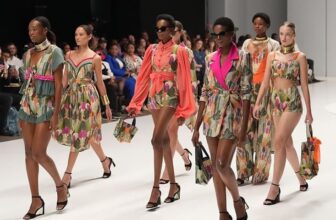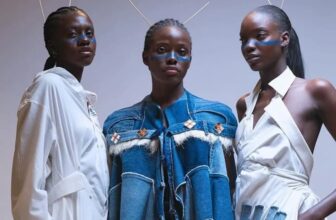Trends are a constant presence in the fashion industry, consistently met with scrutiny, particularly when they intersect with concerns related to health, the environment, or culture. People often strive to align themselves with a specific fashion mood, and while fashion trends can certainly catch the public’s attention, they occasionally make headlines for less favorable reasons due to their controversial, contentious, impractical, or even offensive nature.
Fashion trends offer a potent means of self-expression, yet they also bear the responsibility of advancing inclusivity, body positivity, cultural awareness, and sustainability, especially as society progresses and discussions on pressing social issues persist. When trends fail to uphold these values and societal sustainability expectations, they rightfully draw negative attention and criticism.
Ahead, we explore seven fashion trends that have garnered and continue to garner unfavorable publicity, shedding light on the myriad issues that can emerge in the fashion industry, ranging from health risks and cultural insensitivity to environmental consequences and societal norms. Most of these critiques stem from a disapproval of fashion trends that prioritize aesthetics at the expense of functionality.
Size-Zero Models
Over the years, the fashion industry has prominently featured the concept of “size zero.” It designates models with exceptionally low Body Mass Index (BMI) scores, which assess body fat based on height and weight. However, the industry’s promotion of extremely thin models has drawn criticism for endorsing unhealthy body ideals and contributing to the prevalence of eating disorders.
Tragically, this issue was underscored by the untimely deaths of three models: Uruguayan sisters Luisel and Eliana Ramos, who passed away within six months of each other at the ages of 22 and 18, and Brazilian model Ana Carolina Reston, who was just 21 years old.
These tragedies unfortunately garnered sensationalized media coverage about eating disorders amongst fashion models. In response to the negative impact of the size zero model trend on the fashion industry’s progressiveness, ongoing efforts have emerged to promote healthier body images and foster diversity within the fashion world.
The Corset Diet Trend
The revival of the waist corset, propelled into the limelight by celebrities (You’d understand better if you’re a fan of Game of Thrones, Bridgerton, or Queen Charlotte), has faced criticism for propagating unrealistic body ideals. This trend entails donning exceedingly tight corsets for extended periods with the aim of achieving an hourglass silhouette.
Although adopting this medieval-style attire won’t fundamentally alter your body shape, it is suggested that it may indirectly aid in weight management. Wearing a corset can potentially curtail stomach expansion during meals, leading to a quicker sense of fullness and smaller portion sizes.
Following a few weeks on a corset-based regimen, weight loss may indeed occur. Nevertheless, these practices have been met with concerns related to promoting unhealthy body image, compressing organs, impeding breathing, and the potential for long-term health complications, including internal organ damage.
Underwear as Outerwear
The underwear as an outerwear trend has seen an unexpected surge in popularity this season, even surpassing recent years. Notably, the no-pants craze of 2023, which is being popularized by celebrities.
This trend has a complex history, plunging deeper into the annals of fashion evolution. The act of donning lingerie and underwear as everyday attire has sparked debates due to concerns about immodesty and the objectification of individuals, primarily women. Critics contend that it can sexualize clothing and convey problematic messages regarding consent and personal autonomy. Despite this, many fashion enthusiasts have taken this trend to the extreme, fully embracing the boldness of wearing underwear as outerwear and fans even love it.
Logomania
The fashion industry exhibits a diverse range of opinions when it comes to logomania. Supporters view it as a means to embrace or challenge the established norms. Critics, on the other hand, argue that it conforms to the very same norms, pushing consumers to overspend in their quest for social status.
Logomania traces its roots back to 1925 when Coco Chanel introduced her intertwined “CC” initials. Since then, logos have grown more prominent and assertive. Logomania, as a term, refers to the excessive incorporation of brand logos onto clothing and accessories.
Logomania denotes the excessive use of brand logos on apparel and accessories. Luxury brands renowned for their craftsmanship, such as Saint Laurent, Balenciaga, Gucci, and Louis Vuitton, among others, have embraced this trend. Predictably, it has faced headline scrutiny for endorsing materialism and consumerism, potentially eroding individuality in fashion and promoting conspicuous consumption.
Ripped and distressed clothing
Fashion actions like tearing, ripping, or slashing fabric threads before sale, have been a long-standing practice. And, over the years, we’ve seen denim pants resembling what can only be described as bad and ugly.
Denim and other clothing items such as hoodies or t-shirts with weird and nibbled look like they’ve been rough-handled by rats or dogs. Initially rooted in punk and grunge fashion, the trend of worn and torn garments has since gained widespread popularity. However, it has drawn criticism on a couple of fronts. Some argue that it might inadvertently romanticize financial hardship and downplay the challenges faced by those unable to afford new attire.
There is another contention that donning artificially distressed clothing may demonstrate insensitivity, given that some individuals have no choice but to wear distressed attire. Additionally, there are concerns that this trend can be seen as a type of cultural borrowing when it mimics the do-it-yourself aesthetic of marginalized communities.
Disposable fashion (single-use clothing)
The rise of “fast fashion” has spurred the widespread production of affordable but lower-quality clothing, raising concerns about its impact on the environment and labor practices. Environmental advocates and labor rights supporters have voiced their opposition to this trend due to its adverse effects on both the natural world and the workforce.
The fast fashion industry, known for its “throw-away culture”, is currently being examined for its environmental and ethical consequences. The excessive production of inexpensive, low-quality garments significantly contributes to pollution and generates excessive waste, resulting in a growing criticism of fast fashion, especially in the context of sustainability conversations within the fashion industry.
Thigh gap obsession
A thigh gap refers to the space between a woman’s inner thighs when she stands upright with her feet together. The concept gained widespread attention in December 2012, following the Victoria’s Secret Fashion Show, which showcased models with noticeable thigh gaps.
Images of thigh gaps became prevalent on “thinspiration” blogs and various social media platforms. This trend prompted individuals to strive for a visible gap between their thighs while standing with their feet close together.
Unfortunately, this pursuit of an unrealistic body standard has had adverse effects, contributing to body image issues and eating disorders, particularly among young women. The thigh gap trend even sparked discussions in the media, with some outlets, like The Times of India, referring to it as a “mania.”
Photos courtesy – Miu Miu, Christian Siriano, Coperni






